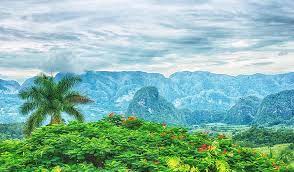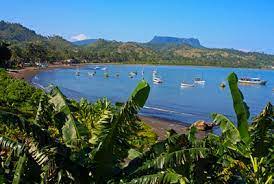MAGDALENA “MIMA” ROVENSKAYA, LA DAMA RUSA QUE HIZO DE CUBA LA TIERRA DE SU LEYENDA. PHOTOS.
Magdalena Menasse Rovenskaya, una ciudadana rusa tenía solo seis años cuando su padre fue ejecutado durante la revolución bolchevique de 1917 en Rusia. Con su madre huyó a las montañas y luego a través de Turquía, Francia, Italia y finalmente a Cuba. La nación insular la embrujó, y ella y su esposo se radicaron en Baracoa.
ERA 1924 cuando llegó a Constantinopla (Estambul), donde conoció a Albert Menasse, diplomático ruso en Turquía, con quien inició un viaje por Java, Italia, Francia y finalmente Cuba, la tierra de su leyenda.
Se casaron en París. Albert se convirtió en comerciante de joyas; ella, como ‘Mima Rovenskaya’, trabajó como bailarina, pianista y cantante, actuando en importantes escenarios como la Ópera de París, la Ópera de Milán, en Las Palmas y en Madrid. A la muerte de su padre, Albert se hizo cargo del negocio de su padre. en la zona del Caribe y él y su esposa viajaron a La Habana donde Magdalena conoció a la Acera del Louvre y a los intelectuales cubanos de la época.
Daba exitosos conciertos, pero eran tiempos de crisis económica.Baracoa, aunque lejana, atraía el matrimonio porque allí había buenos negocios por el boom bananero y las actividades comerciales de las empresas americanas, allí Alberto Menasse se incorporó a la Respetable Logia Masónica de los Trabajadores de Oriente, convirtiéndose en su Venerable Maestro, abrió un negocio de joyería, curtiduría, bar-restaurante y compró varias fincas a las que se incorporó después Magdalena.
Baracoa ejerció su brujería sobre esta elegante mujer ya cambio la atractiva rubia hechizó a la población. Echó raíces y en 1944 obtuvo la ciudadanía cubana.
En 1953 construyeron este hotel en un extremo del Malecón, que se terminó el mismo año y lo llamaron Miramar. La vida de la ciudad pronto se centró en ella y fue muy utilizada por empresarios, estadounidenses asentados en la base de Guantánamo y en Nicaro e incluso por Errol Flynn.
Y cuando Fidel Castro y el Che Guevara iniciaron la revolución que derrocaría el régimen del dictador Fulgencio Batista en 1959, La Rusa fue una ferviente partidaria, a pesar de su propia experiencia con la revolución en Rusia cuatro décadas antes. Su propia prosperidad no cegó a La Rusa sobre el destino del pueblo. Se compadeció del pueblo luchador que la rodeaba y se identificó con el movimiento juvenil que a partir de 1953 intentó combatir la tiranía de Fulgencio Batista. Les ayudó con dinero y medicinas y así, paradójicamente, se vio envuelta en un proceso revolucionario de la misma índole que aquel del que tan precipitadamente huyó a principios del siglo XX.
“Miramar” tambien llamado el Hotel La Rusa, un edificio amarillo bilioso en el paseo marítimo de la ciudad, o Malecón. Lleva el nombre de esta dama Magdalena “Mima” Menasse Rovenskaya.
LUEGO LLEGÓ LA REVOLUCIÓN DE 1959…
El Hotel La Rusa aún existe (Ahora llamado El Encanto La Rusa), aunque desde los años sesenta fue tomado por el estado. Donde se muestran pertenencias personales como un pequeño museo con recuerdos de la Mima de Rovenskaya.
Aunque la rusa entregó las joyas y toda la ayuda que pudo a los trinfadores en 1959, nada se tomó en consideración y sus propiedades fueron incautadas por el gobierno, Mima murió un 5 de Septiembre de 1978 sin reconciliarse con el comunismo. Su caso aún genera algunos malentendidos y problemas en Baracoa, donde vivió los mejores años de su vida.
A la tierra de Baracoa dedicó más de las dos terceras partes de su existencia, el encanto de esta ciudad hace que se establezcan en ella, donde enriqueció la cultura y el nombre de la Villa Baracoa.
En una ocasión, un funcionario de una televisora, al recordar su vida en un informativo, dijo que Magdalena “huyó del socialismo en la Unión Soviética y se refugió en Baracoa” (sic). No pasó nada, pero en las caras de los oyentes y espectadores que los han conocido, se podía ver la tristeza de este episodio de la vida real.
Alejo Carpentier la inmortalizó en su personaje Vera, cuando escribió su novela La Consagración de la Primavera, como embrujadora figura que de boca en boca ha trascendido el tiempo y el espacio.
Magdalena, Mima, La Rusa… su nombre marca un período de la historia del Primer Poblamiento de la Isla de Cuba, donde inscribió su nombre como una de las mujeres más universales de Baracoa.
MAGDALENA “MIMA” ROVENSKAYA, A RUSSIAN LADY WHO MADE CUBA THE LAND OF HER LEGEND. PHOTOS.
Magdalena Menasse Rovenskaya, a Russian citizen was just six years old when her father was executed during the 1917 Bolshevik revolution in Russia. She with her mother fled to the mountains and then through Turkey, France, Italy, and finally to Cuba. The insular nation bewitched her, and she and her husband settled in Baracoa.
It was 1924 when she arrived in Constantinople (Istanbul), where she met Albert Menasse, a Russian diplomat in Turkey, with whom she began a journey through Java, Italy, France, and finally Cuba, the land of her legend.
They got married in Paris. Albert became a jewelry dealer; she, like ‘Mima Rovenskaya’, worked as a dancer, pianist and singer, performing on important stages such as the Paris Opera, the Milan Opera, Las Palmas, and in Madrid. On the death of his father, Albert took over his father’s business. in the Caribbean area and he and his wife traveled to Havana where Magdalena met Acera del Louvre and the Cuban intellectuals of the time.
She gave successful concerts, but they were in times of economic crisis. Baracoa, although far away, attracted marriage because there was good business there due to the banana boom and the commercial activities of American companies, there Alberto Menasse joined the Respectable Masonic Workers’ Lodge de Oriente, becoming his Venerable Master, opened a jewelry business, a tannery, a bar-restaurant, and bought several farms that Magdalena later joined.
Baracoa exercised witchcraft over this elegant woman and in return her attractive blonde cast a spell on the population. She put down roots and in 1944 she obtained Cuban citizenship.
Four years later, the couple abandoned their other commercial activities and, taking advantage of a space previously occupied only by prickly pears and sea grapes, right in front of the Atlantic Ocean, they built a hotel. It was finished in 1953 and they called it Miramar. City life soon became centered around it and it was widely used by businessmen, Americans based at the Guantanamo base and Nicaro, and even by Errol Flynn.
In 1953 they built this hotel at one end of the Malecón. And when Fidel Castro and Che Guevara launched the revolution that would overthrow the regime of dictator Fulgencio Batista in 1959, La Rusa was an ardent supporter, despite her own experience with the revolution in Russia four decades earlier. Her own prosperity did not blind La Rusa to the fate of the town. She felt sorry for the fighting people that surrounded her and identified with the youth movement that from 1953 tried to combat the tyranny of Fulgencio Batista. She helped them with money and medicines and so she, paradoxically, found herself involved in a revolutionary process of the same nature as the one from which she so hastily fled at the beginning of the 20th century.
“Miramar” also called the Hotel La Rusa, a bilious yellow building on the city’s waterfront, or Malecón. It is named after this lady Magdalena Menasse Rovenskaya.
THEN CAME THE REVOLUTION OF 1959…
The Hotel La Rusa still exists (Now called El Encanto La Rusa), although since the sixties it was taken over by the state. Where personal belongings are displayed in a small museum with memories of the Rovenskaya Mima.
Although the Russian gave the jewels and all the help she could to the winners in 1959, nothing was taken into consideration and her properties were seized by the government. Mima died on September 5, 1978, without reconciling with communism. Her case still generates some misunderstandings and problems in Baracoa, where she lived the best years of her life.
She dedicated more than two-thirds of its existence to the land of Baracoa, the charm of this city makes them settle there, where she enriched the culture and the name of Villa Baracoa.
On one occasion, a television station official, when recalling her life in a news program, said that Magdalena “fled from socialism in the Soviet Union and took refuge in Baracoa” (sic). Nothing happened, but in the faces of the listeners and viewers who have met them, you could see the sadness of this real-life episode.
Alejo Carpentier immortalized her in the character of her Vera de Ella, when he wrote his novel The Rite of Spring, as a bewitching figure that by word of mouth has transcended time and space.
Magdalena, Mima, La Rusa… her name marks a period in the history of the First Settlement of the Island of Cuba, where she inscribed her name as one of the most universal women of Baracoa.
Agencies/ CubaSM/ Baracoaorg./ Wiki/ Extractos/ Excerpts/ Internet Photos / Arnoldo Varona / www.TheCubanHistory.com
THE CUBAN HISTORY, HOLLYWOOD.
FOLLOW US ON TWITTER AND FACEBOOK. THECUBANHISTORY.COM










